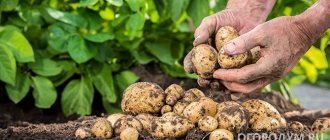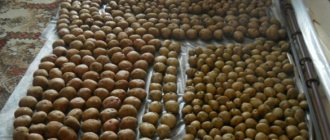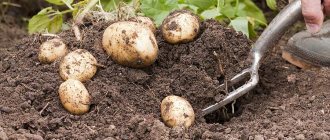Basic rules for storing potatoes
The list of basic rules for storing potatoes on the balcony consists of the following points:
- Rotten, deformed and damaged potatoes should be removed before placing in the container.
- Wet tubers quickly deteriorate or germinate ahead of time, so owners wipe and dry the fruits during preparation.
- Unwashed fruits will last longer. It is advisable to peel potatoes that need to be cooked quickly under running water.
Did you know? Potatoes were introduced into culture by the inhabitants of the territory of modern Bolivia about 8 thousand years ago.
Preparing potatoes for long-term storage
To ensure safety:
- potatoes are sorted, sorting out diseased, damaged, soft tubers;
- diseased tubers are disposed of, damaged ones are given to livestock feed or put in a separate box for use first;
- remove large lumps of adhering dirt;
- dried;
- placed for storage in bags, boxes or prepared bins.
Antimicrobial treatment options (if necessary):
- 100 gr. crushed garlic for every 100 kg. potatoes successfully resist the formation of rot.
- It is useful to sprinkle the tubers with crushed dry leaves of mountain ash.
- Spraying with onion and rowan tincture saves from spoilage. The decoction is prepared at the rate of 50 g. leaves and husks per 1 liter. water. Consumes 1.5 liters. tinctures for every 100 kg. harvest.
In early spring, germination prevention is required. To do this, potatoes are sprayed with M-1. Hydrel has a similar effect.
What and how to store potatoes on the balcony in winter: basic methods
Choosing a container is an important factor in storing potatoes. The type of container determines how long the fruits will remain fresh. It is advisable to use boxes (wooden or plastic), a factory thermal box and temporary containers.
Find out how you can use potato tops.
In wooden boxes
Wooden boxes are the best option for storing potatoes. Wood is a natural, eco-friendly material that promotes normal air circulation. For better preservation, containers with side holes for ventilation are suitable. It is advisable to place the boxes on racks so that they do not stand on a cold floor - hypothermia has a detrimental effect on the condition of vegetables.
In plastic boxes
Many gardeners are skeptical about storing potatoes in synthetic boxes. However, modern plastic containers are mostly made from environmentally friendly plastic. Ventilation holes will help keep vegetables in good condition - in containers of this type they should be in the walls and at the bottom.
Important! Boxes must be cleaned and washed before loading vegetables.
For a compact arrangement, it is better to choose models that can be stacked on top of each other and fastened together, creating something like a rack.
In a factory-made thermal box
Factory-made thermal boxes in urban environments replace cellars and basements, for which they are called “balcony winter cellars.” Thermobox, or thermal cabinet, is a fully automated container for storing vegetables. Visually, it resembles a horizontal refrigerator with a lid on top and a hollow internal structure. The advantage of this method is that the temperature is determined by the owner of the device. Manufacturers also provide forced ventilation, which is why the fruits do not rot or rot.
In a temporary container
Temporary containers are suitable for storing small quantities of potatoes.
Method 4. Storing potatoes in the refrigerator
It would seem that what could be more natural and simpler than storing potatoes in the refrigerator. After all, this method has a number of advantages:
- you can stably maintain the optimal temperature (3-5°C) throughout the winter;
- no preliminary preparation or disinfection of the storage is required.
Potatoes develop a sweet taste when stored in the refrigerator.
Why it is not recommended to store potatoes in the refrigerator:
- you can put only a few kilograms of potatoes in it;
- It is not clear what to store potatoes in. Polyethylene and plastic packaging does not allow potatoes to “breathe”, debris spills out through mesh bags, and the best (but not very reliable) option is paper bags;
- It is not recommended to store potatoes in the refrigerator for a long time - starch begins to turn into sugar, which affects the taste, texture and benefits of potatoes for the body.
This method is more suitable for small stocks of tubers that can last a maximum of 7-10 days.
How to make a box for storing potatoes on the balcony in winter
If desired, the owner can build a balcony potato box with his own hands. The size of the bars for the frame and materials for the cladding is determined by the owner. First, you need to determine the shape (horizontal or vertical) and size of the box by drawing a drawing.
Video: how to make a potato box on the balcony
Tools and materials for work
For manufacturing you will need the following materials:
- bars 50×50 (12 pcs.);
- boards, plywood or chipboard (6 pcs.);
- nails;
- hinges for the lid;
- screws.
Tools needed:
- hammer;
- screwdriver
Step-by-step manufacturing instructions
The instructions for making a box with a lid are as follows:
- Use a hammer and nails to create a frame for the box.
- Cover the frame with plywood, boards or chipboard.
- Attach hinges to the back wall and cover made of plywood, boards or chipboard using screws and a screwdriver.
Important! For thermal insulation, craftsmen advise
the lower parts on vertical bars as legs.
In this case, the bottom should be designed 5–10 cm
above the floor.
At what temperature do potatoes grow? How should you plant potatoes? Secrets of a good harvest.
Unpretentious potatoes can be grown in almost all climatic zones. But a good harvest does not always depend on natural conditions - growing potatoes has its own characteristics and secrets that will be useful to both experienced and novice gardeners.
What do you need to know about planting potatoes in the spring? The soil for spring planting of potatoes is prepared in late autumn. It is dug up to a depth of 20-30 centimeters, and the layers of earth are turned over.
This is done so that in the spring there is less grass - the roots remaining at the top freeze and the weeds die. It is also necessary to add manure or humus, add ash at the rate of 1 kilogram per hundred square meters of land.
To avoid the appearance of various diseases, it is not recommended to apply fresh manure when planting potatoes in spring. Starting from the end of April, you can begin planting work. By this time, the first leaves appear on the birch tree, the soil dries out and the air warms up to 10?15?C. Approximately two weeks before planting, potatoes selected for this purpose are germinated at a temperature of at least 15?C.
After the appearance of sprouts 1 cm long, the seed tubers are kept in the light for one day. From such seeds, 10% more stems develop than from planting material without sprouts. After what crops should potatoes be planted?
Compliance with the rules of agricultural technology is the key to a good potato harvest. Experts advise planting it on lands that were previously used for planting other root crops, cabbage, and mustard.
You should not cultivate potatoes after tomatoes: both belong to the nightshade family, which is fraught with the same diseases. How deep should potatoes be planted?
There are many ways to plant potatoes, their choice depends on the topography of the land, climate, and personal preferences. - In small gardens, potatoes are still planted the old fashioned way - under a shovel. This method is quite acceptable on light soils where groundwater never rises to the surface.
It is recommended to plant potatoes manually to the depth of a scoop of a regular bayonet shovel. — On wet soils, the method of planting potatoes in ridges 15–20 cm high has proven itself well; they are cut using a tractor or garden equipment. — When planting potatoes in trenches, shallow furrows (about 10 cm) are first prepared, which are lined with a layer of humus. Tubers are hilled on both sides until a ridge 10 cm high and 20 cm wide is formed. - A popular method of planting potatoes “under straw” is practiced on virgin lands.
In this case, there is no need to dig up anything - the potatoes are covered with a thick layer of straw, constantly adding the amount depending on the intensity of shoot growth. How to choose the right variety of planting potatoes?
A rich potato harvest can only be obtained by using high-quality planting material. In addition, it is necessary to periodically change varieties; many of them become unproductive after two or three years.
It is better to cultivate several varieties of potatoes with different periods of ripeness at once. Preparing potatoes for planting begins in the fall - only tubers that are not affected by diseases and typical for a given variety are selected. It is advisable to wash them and treat them with a weak solution of potassium permanganate.
Then the planting potatoes are air dried until they acquire a greenish tint. Store in the basement until spring. When choosing the best varieties of potatoes for planting, you should decide for what purpose you plan to grow this crop: for quick consumption or for storage.
Also, be sure to pay attention to zoned varieties that are suitable for the soil of your particular site. All potato varieties are classified according to ripening time. - Early ripening - the crop is harvested no later than 80 days after planting.
Popular varieties: “Zhukovsky”, “Udacha”, “Fresco”. They have excellent taste, but are unsuitable for long-term storage. - Mid-season varieties usually ripen within three or three and a half months, they are well stored until spring.
Popular varieties: “Sineglazka”, “Zhuravinka”. - Late-ripening varieties are harvested in the fall, they are ideal until the new harvest. These are varieties such as “Temp”, “Belorussky-3”, “Chugunka”, “Alpinist”. If you dare to plant potatoes before winter, you will get a unique opportunity to please yourself with an extra-early harvest of this popularly loved crop.
So: - choose a well-lit place near buildings; - carefully remove weeds and fertilize the soil; - in the middle of summer, plant one potato in each hole, water it; - periodically we weed and loosen the soil; - before frost, we cut off the tops, cover the plants with leaves, straw, spruce branches; - in winter, we make sure that the plantings are reliably covered with snow. It is believed that the probability of obtaining a harvest from potatoes planted before winter is 50%. Good luck!
Common mistakes
Even experienced gardeners are not immune to making mistakes.
Among the most common are the following:
- Temperature below 0°C . Mistakenly believing that frost promotes long-term storage, owners do not control the lower temperature limit. As a result, the vegetables freeze and most of them become unusable.
- Accommodation on an open balcony . As in the previous paragraph, the problem lies in the overcooling of the tubers. It is better to avoid unglazed rooms.
- Washing the tubers . Washed potatoes will not remain fresh for long. Such processing is necessary immediately before eating.
- Storing spoiled fruits . Dispose of damaged and rotting specimens at the preparation stage. It is advisable to check vegetables throughout the entire period for rot, drying out or other damage - storing such fruits with other vegetables is highly not recommended.
Did you know? One of the deities of the ancient Incas pantheon was Axo-mama, the goddess of potatoes.
Storing potatoes on the balcony is not at all difficult if you choose the right container and maintain the necessary conditions. With properly organized storage, vegetables will retain their freshness and pleasant taste for a long time.
At what degrees do potatoes freeze on the balcony? Freezing of potatoes during storage
Both storing potatoes in a cellar and storing potatoes in a basement involves protecting the crop from freezing.
The question of at what temperature do potatoes freeze has been discussed more than once on various Internet forums, and many articles have been written about this. Any temperature below zero, or even zero, is considered negative. At minus 1, partial freezing occurs, and at 3–4 degrees below zero, the potatoes freeze. Even if you store potatoes in the cellar, there is a possibility that frost will reach there. If the cellar or basement is not insulated, and the harvest has not yet been dug up, it’s time to take care of insulation.
At the same time, if the storage facility is located outside the house, then you can build additional protection from frost, snowfall and winds - a canopy or roof. The descent hatch is also insulated with foam plastic or other insulating material.
But when creating the best storage conditions, you should not be too zealous. Otherwise, the temperature of the initial freezing of potatoes will smoothly develop into the temperature of its germination. And sprouts begin to appear already at 4 degrees.
When storing potatoes on an unheated balcony or in a garage, there is often a danger of vegetables freezing. The condition of the tubers depends on the air temperature in the storage:
- at temperatures from 2 to 5 °C, potatoes retain their taste; at higher temperatures, they germinate prematurely and begin to wither;
- from 0 to 1 °C, short-term decreases to -1 °C, starch begins to break down, and over time a sweet taste appears;
- potatoes freeze at a temperature of -1.7 °C and below, acquiring a pronounced sweet taste. As the temperature rises, frozen tubers begin to rot; those intended for planting lose their viability.
General recommendations
The most important criterion for preserving the taste of potatoes throughout winter storage is the correct choice of vegetable:
- early potato varieties are not suitable for the chosen purposes;
- potatoes must be dry. Wet potatoes are susceptible to rapid rotting and premature sprouting;
- If, when purchasing potatoes, spoiled or dented or rotten tubers were found, then you should not take such a batch. The fact is that even one potato in a box can “infect” the entire stock;
- The thickness of the peel is critical. The thicker it is, the longer the shelf life of a given batch, and the better all the taste of the product will be preserved.
For storage you need:
- Shake the tubers off the ground.
- Dry the crop. This is the most important stage of preparation. A wet vegetable is more prone to rotting. Drying is carried out on a warm day on a blanket in direct sunlight. You can do this at home by drying the root crop on the loggia or balcony. Excess moisture should leave the entire surface of the root skin.
- Sort damaged and unhealthy potatoes from whole ones. Healthy tubers can be stored, and those that are damaged can be hidden in the refrigerator and eaten as soon as possible.
- Place in boxes and bags and place in a suitable storage location.
How to prepare potatoes for wintering
Is it possible to cook blackened potatoes?
Regardless of where root crops are stored, they must first be prepared
Wet, too dirty, overcooled vegetables will quickly begin to deteriorate - they will become moldy and rot, so before storing you need to pay attention to preparation
A healthy and clean harvest can be recognized by the condition of the tubers
Activities for preparing vegetables largely depend on where they are purchased. For your own harvest, you need to carry out a whole range of measures, and the purchased one is usually already ready for storage. However, irresponsible sellers sometimes violate the rules for collecting, drying and sorting, so even when purchasing seemingly clean and healthy root vegetables, they must at least be sorted out and carefully inspected.
For preparing homemade dishes, the best tubers are medium-sized, with healthy skin, without damage, sprouts or rot. To identify substandard conditions, a hygienic audit is usually carried out:
- sort through all the root crops, clean them of dirt and debris;
- get rid of wet, moldy and rotten tubers;
- remove root vegetables with green skins, which are considered unsuitable for food due to the solanine they contain (a toxic substance that can cause poisoning);
- If possible, divide potatoes into small and large, as well as by variety: hard - for frying, soft - for mashed potatoes and soups;
- Vegetables with fresh cuts and dents are set aside for first use, since they will not survive long-term storage.
There is debate about whether tubers should be washed. Villagers believe that a thin layer of “native” soil serves as additional protection, while city dwellers claim that washed vegetables are better tolerated when storing potatoes on the balcony in the fall and winter. Although their opinion is most likely driven more by personal comfort: it’s easier to wash all the supplies at once than to deal with dirty root vegetables every day.
Preparing potatoes for baking in the oven
Experts, taking into account the shorter “life” of washed tubers, advise leaving large reserves simply in a cleaned state, without washing. If you plan to use the potatoes in the first month, then you can safely wash them - in the kitchen sink, going over all the tubers with a brush or sponge. Then the vegetables must be dried, since even one damp spot can provoke the appearance and rapid spread of rot.
Basic mistakes when storing potatoes
To ensure that the potatoes last until spring, do not rot, do not become covered with mold and signs of disease, and do not begin to sprout, try to avoid typical mistakes in storing them.
- Store only potatoes of the correct variety. Early varieties are suitable for food only before the onset of cold weather, and after that, even under ideal storage conditions, they begin to sprout or dry out and become lethargic. And all because early-ripening potatoes are not intended for storage;
- Only high-quality potatoes should be stored. Cheap tubers have a short lifespan: if you save on purchasing, you will regret it when you have to throw away a third of the stock;
- Often sorted potatoes are put in for winter storage, and along with them other vegetables, after which it turns out that part of the product has disappeared. Why? Potatoes are stored well only with beets, as they absorb moisture well. Other vegetables in the neighbors will only speed up the rotting process.
By carefully preparing your balcony storage, you can enjoy delicious, good quality potato dishes all winter.
Preparation
After digging up potatoes, there is no need to rush to put them in bags, containers, cover and transport them, or expose them to sudden temperature changes.
Before storing, the harvested crop must undergo preparation, which will preserve the beneficial properties and original appearance of the vegetable for a long time. The preparation process takes place in several stages:
- First, the tubers are dried. If the weather is clear and the soil is sandy, you can scatter them directly in the garden and let them lie for 2-3 hours in the sun to disinfect them from harmful bacteria and fungi. Many gardeners dry potatoes under a canopy to protect the crop from bad weather (in case it rains). One or two days is enough for the adhering soil to fall off the tubers and for their skin to dry out.
- Then the potatoes are cleaned of the remaining soil, which is now easily removed, and sorted: tubers with mechanical damage, rotten and lethargic, as well as those affected by diseases: late blight, wireworm, cancer, etc. are selected; it is better to dispose of them immediately. Large potatoes are selected for storage, but they are stored only until mid-winter, then voids can form inside and the taste may deteriorate greatly, medium ones - for planting and longer storage, small ones and those affected by mechanical damage are spent primarily on cooking or food for pets. animals.
- Sorted products are treated with any anti-fungal drug (phytosporin, bactofit or analogues). Some gardeners disinfect potatoes: they wash them in a bright pink solution of potassium permanganate, and then dry them thoroughly. This procedure is not necessary, but it allows you to keep the tubers in perfect condition, preventing them from spoiling.
- After this, the potatoes are placed in a shaded place for two weeks (or under a canopy). During this time, excess moisture will disappear, and the vegetable peel will become denser.
- When the tubers are thoroughly dry, they are placed in bags, nets, boxes and sent for storage.
Potatoes selected for planting are stored separately, but before that they are kept in fresh air until a green tint appears on the skin. When exposed to the sun, it turns green due to the release of solanine, which is harmful to humans, but at the same time it extends the shelf life of the vegetable and accelerates the germination of the root crop after planting.
The most beautiful, smooth tubers without defects, medium and small in size, are selected for seeds.
To save the maximum amount of harvest, potatoes are sorted once a month. They remove spoiled and rotten ones so that putrefactive processes do not spread to healthy tubers.
Temperature
The optimal temperature for storing potatoes is +2-4 degrees. In such conditions it does not freeze, does not wither and does not germinate. At lower values, the risk of rot increases, but at minus levels, starch is converted into sugar, which makes the potatoes taste sweet. But despite this, frozen tubers are suitable for eating.
This temperature regime is maintained until March, until the end of the natural dormancy period, after which it is recommended to lower the temperature to +1 degree so that the potatoes do not begin to germinate.
As the degrees rise, the tubers produce sprouts that quickly draw out all the juices. The vegetable becomes limp, wrinkled and tasteless.
Preparing the balcony for storage equipment
If you decide to make repairs on the balcony and organize boxes for long-term storage of vegetables, fruits and seams, you should take care of some nuances.
They mainly concern the creation of a suitable microclimate. For the southern regions, it will be enough to glaze and insulate the balcony or loggia itself from weather conditions. Areas with harsh winters dictate different rules - here it is worth taking care of complete insulation of the room. Balcony insulation with modern penoplex!
Also important:
- completely clean the room from dirt, dust, check it for insects;
- treat surfaces with anti-insect compounds;
- use environmentally friendly materials during repairs (wood, mineral wool for insulation, etc.);
- provide curtains or blinds for the windows.
Before you start building boxes and installing shelving, you need to completely measure the room and sketch out a rough plan for the location of the different parts of the storage. This will help you purchase the exact amount of materials and not make mistakes with the dimensions during installation.











